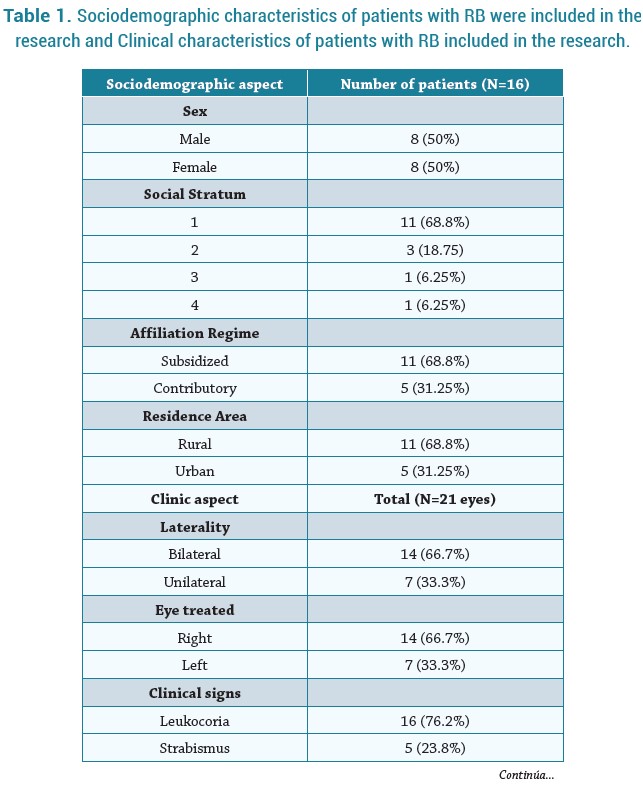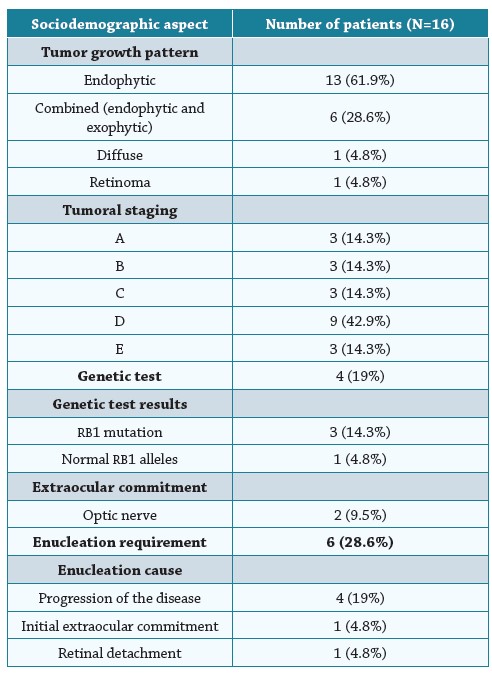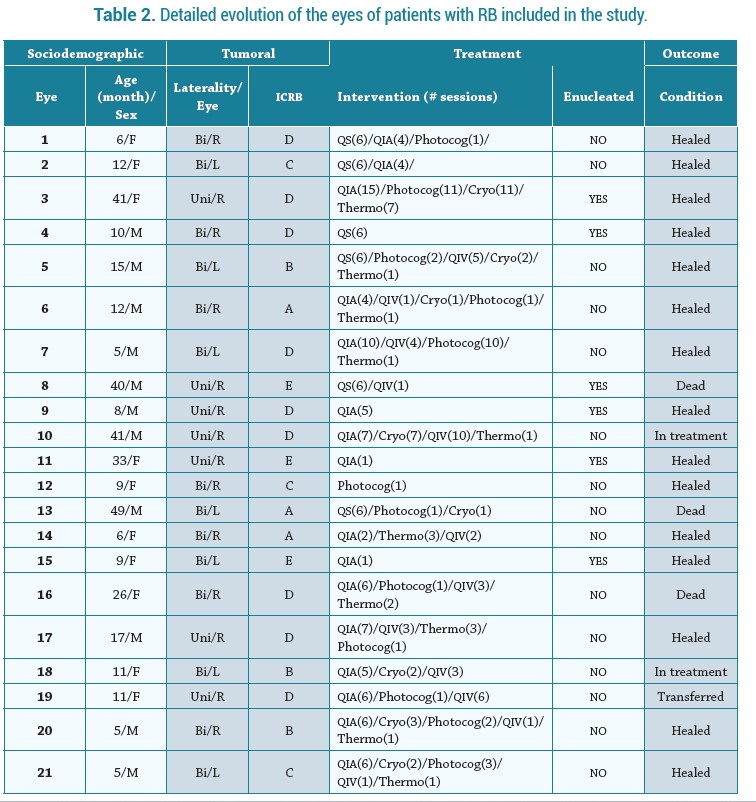Fecha de recepción: 17 de marzo de 2023 Fecha de aceptación: 15 de junio de 2023
ARTíCULO ORIGINAL https://dx.doi.org/10.14482/sun.40.01.345.916
Characterization of Retinoblastoma Patients in a Referral Center on the Colombian North Coast
Caracterización de pacientes con retinoblastoma en un centro de referencia de la costa norte de Colombia
Ana María álvarez Castillo1, Cesar Atencia Niño2, Diana Cifuentes Zapata3, Katia Gutiérrez Brun4, Jaime Moreno Chaparro5, Javier Antonio Amaya Nieto6, Javier Vásquez Ramírez7
1 Surgeon, Universidad de Cartagena. Specialist in Ophtalmology, Universidad de Cartagena. Specialist in Pediatric Ophtalmology and Strabismus, Training in Neuro-ophtalmology, Fundación Oftalmológica Nacional, endorsed by Universidad del Rosario. Certification in Pedagogy, Curriculum and College Teaching, Corporación Universitaria del Sinú. Specialization in Healthcare Management, Universidad Tecnológica de Bolívar. Institution: Centro Oftalmológico Ebenezer. ORCID: https://orcid.org/0000-0003-1641-1608. CvLAC: https://scienti.minciencias.gov.co/cvlac/visualizador/generarCurriculoCv.do?cod_ rh=0000425516 Mail: Anamaria.alvarezcastillo12@gmail.com. Corresponding author: Ana María álvarez Castillo. Research Group Ophthalmology Center, Centro Oftalmológico Ebenezer S.A.S, Cartagena, Colombia, Colombia. email: anamaria.alvarezcastillo12@gmail.com. Phone: (+57)3164926840, Manga, 3ra Av. No 21-166, apartment 10-01, Building America 500.
2 Surgeon, Universidad del Norte. Ophtalmologist, Universidad del Sinú. Specialist in Retina and Vitreus, Clínica unidad laser del Atlántico (Dr. Carlos Abdala). AfiInstitution: Centro Oftalmológico Ebenezer. ORCID: https://orcid.org/0000-0002-9729-6623. CvLAC: https://scienti.minciencias.gov.co/cvlac/visualizador/generarCurriculoCv.do?cod_rh=0000133507 . Mail: Cesaratenciamd@hotmail.com
3 Surgeon, Pontificia Universidad Javeriana. Ophtalmology, Fundación Universitaria de Ciencias de la Salud. Pediatric Ophtalmology and Adult Strabismus, Universidad de California, Los Angeles -UCLA. ORCID: https://orcid.org/0000-0002-2048-9152. CvLAC: https://scienti.minciencias.gov.co/cvlac/visualizador/generarCurriculoCv.do?cod_rh=0001528361. Mail: dianilcz@gmail.com
4 Medical Doctor, Universidad del Sinú. Ophtalmology, Universidad del Sinú. Pediatric Ophtalmology and Strabismus, Foscar. Institution: Centro Oftalmológico Ebenezer. ORCID: https://orcid.org/0000-0002-4334-7253. Mail: katyelen8@hotmail.com
5 Ocupational Therapist, Universidad Nacional de Colombia. Master in Clinical Epidemiology, Pontificia Universidad Javeriana. Adjunt Professor , Department of Medicine, Universidad Nacional de Colombia. Institution: Centro Oftalmológico Ebenezer. CvLAC: https://scienti.minciencias.gov.co/cvlac/visualizador/generarCurriculoCv.do?cod_rh=0000090106 . ORCID: https://orcid.org/0000-0002-5655-3654. Mail: jaamorenoch@unal.edu.co
6 Medical Doctor, Universidad Militar Nueva Granada Master in Clinical Epidemiology, Universidad Nacional De Colombia Sede Bogotá Certification in Clinical Epidemiology, Fundación Universitaria de Ciencias de la Salud - Fucs. AfiliInstitution: Centro Oftalmológico Ebenezer. CvLAC: https://scienti.minciencias.gov.co/cvlac/visualizador/generarCurriculoCv.do?cod_rh=0000066497. ORCID: https://orcid.org/0000-0002-9856-6242. Mail:javier.amayanieto@gmail.com
7 Surgeon, Universidad de Cartagena. Ophtalmologist, Universidad Militar Nueva Granada-Hospital Militar Central Santafé de Bogotá. Institution: Centro Oftalmológico Ebenezer. ORCID: https:// orcid.org/0000-0002-6848-1053. CvLAC: https://scienti.minciencias.gov.co/cvlac/visualizador/generarCurriculoCv.do?cod_rh=0001835805 . Mail: javiervasquez@ebenezeroftalmologia.com
ABSTRACT
Purpose: The purpose of the following study was to describe the sociodemographic, clinical, and therapeutic characteristics of patients with retinoblastoma (RB), the most common intraocular tumor in children, receiving medical care in an eyecare institution in the Caribbean region of Colombia.
Methods: A case series between 2016 and 2021 was carried out. Eyes of patients with RB, receiving medical care in a single health care institution, and in compliance with the established follow-up protocol, were included. Descriptive analyzes of relevant variables were performed.
Results: In this study, a total of 21 eyes of 16 patients were examined. The average age at the time of diagnosis was 17.7 months, and 50% of children were male. Using the International Classification for Intraocular Retinoblastoma, 42.9% of the total cases were classified as group D. Out of the 21 cases, 71.4% went into total remission without the necessity for enucleation, and the most common treatment was chemotherapy, using Melphalan® via intraarterial or intravitreal administration.
Conclusion: Specific findings of patients with RB in the Caribbean Coast of Colombia were identified. These findings imply that, despite the obstacles to healthcare access, an early diagnosis and a treatment plan using intraarterial chemotherapy may provide a satisfactory clinical outcome (remission).
Keywords: Retinoblastoma; Treatment; Intraarterial Chemotherapy; Ophthalmology; Colombia.
RESUMEN.
Objetivo: El propósito del siguiente estudio fue describir las características sociodemográficas, clínicas y terapéuticas de los pacientes con retinoblastoma (RB), el tumor intraocular más frecuente en niños, que reciben atención médica en una institución oftalmológica de la región Caribe de Colombia.
Métodos: Se realizó una serie de casos entre 2016 y 2021. Se incluyeron ojos de pacientes con RB, que recibían atención médica en una sola institución de salud y cumplían con el protocolo de seguimiento establecido. Se realizaron análisis descriptivos de variables relevantes.
Resultados: En este estudio se examinaron un total de 21 ojos de 16 pacientes. La edad media en el momento del diagnóstico fue de 17,7 meses y el 50% de los niños eran varones. Utilizando la Clasificación Internacional para el retinoblastoma intraocular, el 42,9% del total de los casos se clasificaron en el grupo D. De los 21 casos, el 71,4% entraron en remisión total sin necesidad de enucleación, y el tratamiento más habitual fue la quimioterapia con Melfalán® vía intraarterial o intravítrea.
Conclusiones: Se identificaron hallazgos específicos de pacientes con RB en la costa caribe de Colombia. Estos hallazgos implican que, a pesar de los obstáculos en el acceso a la salud, un diagnóstico temprano y un plan de tratamiento con quimioterapia intraarterial pueden proporcionar un resultado clínico satisfactorio (remisión).
Palabras clave: Retinoblastoma; Tratamiento; Quimioterapia Intraarterial; Oftalmología; Colombia.
INTRODUCTION
The most common intraocular tumor diagnosed in children is retinoblastoma (RB). Each year, this condition affects about 8 000 eyes, and survival rates vary significantly between developing and developed countries (1). The retinal tissue is the exact location of the histopathological origin of RB, and it can manifest as either a hereditary or nonhereditary form (2). In 98% of cases, the RB is caused by an allelic inactivation of the RB1 tumor suppressor gene localized on chromosome 13q14 (3). The most common signs, which indicate late stages, include leukocoria and strabismus (4).
The employed therapeutic modalities include chemotherapy, radiotherapy, brachytherapy, and surgery. One of the most efficient approaches, at the moment, is selective intraarterial chemotherapy, which may be utilized at different phases (5).
In Colombia, some other groups have published previous epidemiological data in a 2021 report on the clinical management of RB (6). This study also concludes that significant socioeconomic differences lead to significant variations in healthcare availability among states and regions. Due to all these factors, it is essential to supplement the available epidemiological data on RB with information regarding the sociodemographic, clinical, pathological, and therapeutic characteristics of the patients in the Colombian Caribbean region.
MATERIALS AND METHODS
Design, study population, and study sample: A retrospective case series of patients with RB was conducted. Potential medical records were electronically identified, from 2016 to 2021, at a referral ophthalmology center located on the northern coast of Colombia, using ICD-10 codes, keywords "Retinoblastoma" or reasons for admission to chemotherapeutic treatment, and, then, these records were manually reviewed to confirm the pertinence of its inclusion, which applies to all patients with RB admitted to the referral center on the study date; excluding those patients with previous ophthalmologic treatment outside the institution, and who do not comply with the established follow-up protocol.
Institutional protocol: The initial diagnostic parameters included pediatric, hemato-oncology, genetic, and ophthalmologic evaluation through biochemical laboratory tests, orbits, and brain magnetic resonance imaging, both simple and contrasted with gadolinium, ocular ultrasound. The examination was performed under anesthesia. The ocular treatment was defined, monthly, at medical board meetings, and applied in accordance with the RB stage, based on the International Classification of Retinoblastoma. The different treatments-chemotherapy (intravitreous, intraarterial, and systemic), laser photocoagulation, transpupillary thermotherapy, cryotherapy, and enucleation-were not exclusive. They were combined to obtain the greatest outcomes.
Data: sociodemographic characterization included the general variable collection. The clinical variables used included signs, tumor laterality, growth and staging patterns, genetic tests, and family history of RB. Finally, treatment (type and quantity of drugs), outcomes (enucleation, extension, evolution), and complications were registered.
Statistical analysis: a descriptive analysis was performed using frequency distributions, proportions, means, and standard deviations. For the data analysis the R software (R Core Team (2021) was used.
Ethical considerations: This research was designed and conducted complying with national law. The research protocol (003-2021) was approved by the Ethics Committee of the Universidad de Cartagena.
RESULTS
A total of 21 eyes, corresponding to 16 patients, were diagnosed with RB in the ophthalmologic center during the 6 years of the study. The average age was 17.7 months [range=5; 49], 68.8% (n=11) had low socioeconomic status and some lived in rural areas 68.8% (n=11). See Table 1.
With regards to clinical findings, RB was bilateral in 66.7% (n=14) of the eyes, and 76.2% (n=16) presented leukocoria as a predominant clinical finding (Table 1). The tumor was classified as endophytic in 61.9% (n=13) of the eyes, and type D was the predominant stage of diagnosis (42.9%). In four (19%) eyes, genetic tests were reported, and three of them had a mutation in the RB1 gene.


Regarding treatments, intraarterial chemotherapy was applied (36%), requiring an average of five sessions per eye [range = 1; 15], followed by photocoagulation (14.4%), intravitreous chemotherapy (15.6%), transpupillary thermotherapy (8.4%), cryotherapy (11.6%), and systemic chemotherapy (14%). The most frequently used drug for intravitreous treatment was Melphalan® (64.7%). After treatments, the data showed that 71.4% (n=15) of the examined eyes achieved remission. Table 2 summarizes the evolution of the eyes included in the study, and Figure 1 shows some images of particular cases of RB and their treatment.

Abbreviations. M: male; F: female; Bi: bilateral; Uni: unilateral; R: right; I: left; ICRB: Intraocular Classification of Retinoblastoma; QIA: intraarterial chemotherapy; QIV: intravitreous chemotherapy; QS: systemic chemotherapy; Cryo: Cryotherapy; Photocog: Photocoagulation; Thermo: Thermotherapy.

DISCUSSION
Retinoblastoma is a disease that requires timely diagnosis and effective treatment to improve its prognosis (7). In this study, the characterization of 21 eyes of 16 patients revealed an average age of diagnosis of 17.7 months, similar to what was reported by Fabian et al. (6).
Regarding disease distribution by sex, the data obtained from our study proved to be similar to those reported by other studies (5, 6). Fabian et al. (6) also described that 70% of cases were unilateral, and the remaining 30% were bilateral. Bilateral presentation is associated with a better prognosis when the retinoblastoma is diagnosed at an older age (1, 8). In our study, unilateral involvement was 33.3% of total eyes included, while bilateral was 66.7%.
In our research, only 19% of the patients had access to genetic testing, showing barriers to access to this kind of diagnostic test. This situation can occur due to the high cost of the tests (7) and low availability in our context. An additional essential aspect during the diagnosis of RB is the disease staging, because it potentially impacts prognosis and cure rates. In a study on 14 eyes conducted by Liu et al. (9), 57% of the patients had an RB in advanced stages (D or E group), and at least 93% received intra-arterial chemotherapy as secondary therapy after previous failed treatments. In another report performed in Medellin by González et al. (10), the RB cases in D and E stages was 66%, with secondary treatment of 67%. These results are similar to what we found in our research (57.2% in these stages) and with secondary interventions in 76%.
Another critical aspect of RB is choosing an optimal treatment. Current treatment of RB focuses on the preservation of the eyeball, and the use of intraarterial and intravitreal chemotherapy.
This research has various strengths. It is the first case series of the Colombian Caribbean region. It is also essential to mention that most patients received intraarterial chemotherapy, which brings valuable information on the evolution of the patients that used this treatment approach. Nevertheless, it is not possible to directly extrapolate the results to other populations because of its specific context. We believe that these results could, however, be useful for policy formulation within countries and regions with similar contexts.
CONCLUSION
The results of this study showed some particularities concerning RB patients' diagnostic and treatment process in the Caribbean Colombian region that needs to be addressed and thoroughly investigated. Another critical aspect of RB is choosing an optimal treatment. Current treatment of RB focuses on the preservation of the eyeball, and the use of intraarterial and intravitreal chemotherapy. As a multidisciplinary group, we followed this concept and adopted this patient management guide for the last 5 years. Additionally, these results may suggest that the Colombian health system exhibits problems with healthcare access that can affect the prognosis of these patients, and this must be investigated further.
ACKNOWLEDGMENTS
The authors want to thank Centro Oftalmológico Ebenezer for their financial support and all the parents for their collaboration during the research.
CONFLICT OF INTEREST
The authors declare no conflict of interest.
FINANCIAL SUPPORT
Centro Oftalmológico Ebenezer.
REFERENCES
(1) . Dimaras H, Corson TW, Cobrinik D, White A, Zhao J, Munier FL, et al. Retinoblastoma. Nat Rev Dis Prim [Internet]. 2015 Aug 27;1:15021. DOI: 10.1038/nrdp.2015.21
(2) . Moreno F, Sinaki B, Fandiño A, Dussel V, Orellana L, Chantada G. A population-based study of retinoblastoma incidence and survival in Argentine children. Pediatr Blood Cancer. 2014 Sep;61(9):1610-5. DOI: 10.1002/pbc.25048
(3) . Andreoli MT, Chau FY, Shapiro MJ, Leiderman YI. Epidemiological trends in 1452 cases of retinoblastoma from the Surveillance, Epidemiology, and End Results (SEER) registry. Can J Ophthalmol. 2017 Dec;52(6):592-8. DOI: 10.1016/j.jcjo.2017.05.012
(4) . Pekacka A. The Role of Intra-arterial Chemotherapy in the Management of Retinoblastoma. J Ophthalmol [Internet]. 2020 Jan 24;2020:3638410. DOI: 10.1155/2020/3638410
(5) . Soliman SE, Racher H, Zhang C, MacDonald H, Gallie BL. Genetics and Molecular Diagnostics in Retinoblastoma--An Update. Asia-Pacific J Ophthalmol (Philadelphia, Pa). 2017;6(2):197-207. DOI: 10.22608/APO.201711
(6) . Fabian ID, Abdallah E, Abdullahi SU, Abdulqader RA, Adamou Boubacar S, Ademola-Popoola DS, et al. Global Retinoblastoma Presentation and Analysis by National Income Level. JAMA Oncol. DOI: 10.1001/jamaoncol.2019.6716
(7) . Chantada G, Schaiquevich P. Management of retinoblastoma in children: current status. Paediatr Drugs. 2015 Jun;17(3):185-98. DOI: 10.1007/s40272-015-0121-9
(8) . United States Military Tribunal II. Nuremberg Code [Internet]. 1946. https://www.ushmm.org/information/exhibitions/online-exhibitions/special-focus/doctors-trial/nuremberg-code
(9) . Liu CC, Mohmood A, Hamzah N, Lau JH, Khaliddin N, Rahmat J. Intra-arterial chemotherapy for retinoblastoma: Our first three- and-a-half years' experience in Malaysia. PLoS One.2020;15(5):e0232249. DOI: 10.1371/journal.pone.0232249
(10) . González ME, Gaviria ML, López M, Escudero PA, Bravo A, Vargas SA. Eye Salvage with Intra-Arterial and Intra-Vitreal Chemotherapy in Patients with Retinoblastoma: 8-Year Single-Institution Experience in Colombia. Ocul Oncol Pathol. 2021 Jun;7(3):215-23. DOI: 10.1159/000511980